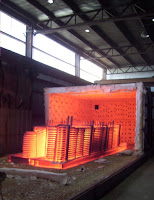During welding, residual stresses are formed in an area referred to as "the heat affected zone" or HAZ. In the HAZ, differential contractions occur as the metal heats, liquifies and then cools to ambient.
Residual stresses have a significant impact on the performance of a weld and their reduction is highly desirable. The undesirable impact of residual stresses in welded metal structures involve fatigue performance and corrosion resistance.
 |
| Heat treatment furnace. |
 |
| PWHT with resistance heaters |
PWHT is proven very effective in reduction of high residual stress around the weld repair. Conventional PWHT can be done by combustion furnace, induction heaters or electric resistance heaters (ceramic pad heaters). Accurate ramp and soak times, as well as data recording can be done with modern power console systems. It is strongly recommended to apply PWHT for all original and repair welds.
